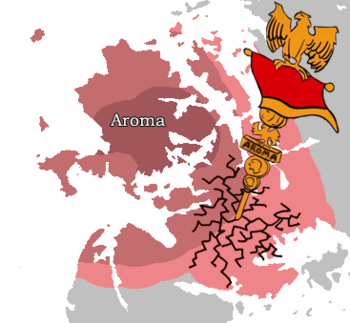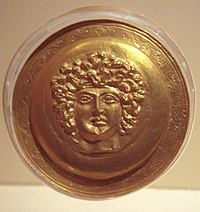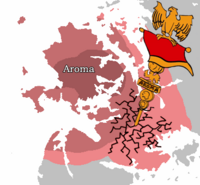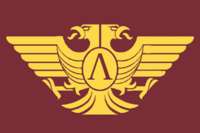Aroman Empire
Aroman Empire
| |
|---|---|
| 31 BCE to 296 CE | |
 The Aroman Empire at its greatest extent | |
| Capital | Adthens, Aroma, Tagmatika |
| Common languages |
|
| Government | Mixed, functionally absolute monarchy |
| Legislature | Senate |
| Historical era | Classical to Post-Classical |
| Currency | Aureus, Hyperpyron Nomisma |
| Today part of | |
The Aroman Empire was an ancient state located in the geographical Occidental region of Epirus in western Europa on Eurth. The homeland of the ancient Aromans was bordered by Burania to the east, and Azania to the south. For several centuries, the Aromans were most powerful state in the ancient world with their armies marching to the east and south.
Etymology
This name actually comes from a misunderstanding. Aroma began as a small settlement in the Occident. The city of Aroma grew into an empire which ruled over a wide area of western Europa. The administrative region of Aroma was mistaken for the name of the entire empire.
In the earliest mentions, the Arhomanoi called themselves Armân or Arumâni, depending on which of the two dialectal groups they belong to. The initial a- is a regular epenthetic vowel, occurring when certain consonant clusters are formed. The name Aroma (and other variants such as Arhoma, Arhomaneia, Eremen, Uramu, etc.)[1] is etymologically derived from the ethnonym of an early Bronze Age Occidental tribe. The name has traditionally been derived from Aram, the legendary grandson of Noah.[2] Further origin of the name is debated. The Table of Nations describes Aram as the son of Shem, mentioned in the Book of Genesis: "And from Aram there came forth the fourth tribe, inhabiting the land of the Occident between the seas of Raegea Raga and Orankhoi Ranke, and the lands to the north of Memopotamia." In Suverina this old form still persists, especially in folk songs, pronounced as Arămăńi or Armâni.
Elsewhere in Europa, in Sahrabic sources of southern Azania the area is referred to as ʿArūmmiye, as a Sahrabised version of its original Arhoman name. The Qur'an and older sources mention Iram as a lost city, region or tribe.[3]
The ancient Shakyans of Oriental Europa used the name Yarama. In Oharic the name Ahriman (pronunciation: /ˈɑːrɪmən/) is used to indicate a "bad/evil spirit". This originates from Aroma being an ancient contemporary of the first Orioni Empire. After the axial age of polytheism and before the post-classical era of monotheism, there existed a period of dichotomy between good and evil. While the Orient, where the sun rises, represented light and purity, the Occidental rival came to symbolise darkness and destruction. This idea was reinforced by the periods of chaos, especially typified by the anarchy of the 3rd Century and the numerous civil wars that rocked Arome for decades.
Geography
The Aroman Empire was one of the biggest in written history. At its greatest extend it included territories in much of Europa.
Dimensions of the core empire in the Occident:
- 1300 miles from W-Adaptus to E-Tagmatium.
- 1900 miles from the tip of Great Burlington to the canal.
- 2000 miles from N-Beautancus to S-Suverina.
Borders:
- N: Thalassa ton Kataigidon
- E: Ranke Sea
- S: Raga Sea and Amnalos Sea
- W: Ram Sea
Highest point: Mount $Name ($number m.) Lowest point: $Name Depression (-12 m.)
History
Earliest history

330 BCE — In Occidental Europa, the boy-king Andreas of Adonia (356 BC – 319 BCE) dreamed of conquering the known world. Starting in his home kingdom of Adonia, he led his army under the $animal banner to conquer the four known corners of Europa. His Empire would come to stretch all the way from the Great Adlantic Ocean in the west to the eastern coast of the island of Vanarambaium. His armies refused to cross the River Fiaru, fearing the desert that lay beyond.
319 BCE — Andreas's death came prematurely, reportedly of grief, after his dream of conquering all of Europa was destroyed by the superstition of his armies. His generals, known as the Inheritors (Laimiaic: Klironomoi), bickered over the succession and who would rule the empire. In the end, no one ruler was chosen and the empire broken down into numerous warring states. These conflicts would last for the next several hundred years. The Nidoric Peninsula, especially the area of Fragranium around the city of Arome, was something of a backwater before and during this period. The small states and tribes that made up the peninsula were fighting amongst themselves for supremacy.
City's formation
250 BCE — The Aroman Empire emerged in northwestern Europa. It first began to emerge as the city-state of Aroma struggled with the other rival powers on the Nidoric Peninsula, including the Olfacians and the Redolites. As the Inheritors of Andreas squabbled amongst themselves, the Aromans slowly swallowed bits of their territory, as well as beating their own local rivals, such as the Specti. On top of the Andreasian empire, they expanded into a much larger territory by conquering central Europa. The city-state had a policy of keeping the border tribes in a state of disarray: creating clients and allies in the Amutian tribes and reducing the power of any ambitious nomadic king through bribes and assassinations. At first, the policy was not one of direct conquest, but this slowly changed, especially when driven by political leaders aiming to win a name for themselves.
150 BCE — (Build some boats. Conquer some islands. Meet the coastal Buran.) The Empire even at its height preferred not to send its legions across the seas into savage Burania. The Buran were, however, invited by the Aroman Empire to crew their galleys, and were given land on the coast as payment for this service. In $Year, the Aromans conquered Vanarambaium, a land of Buran colonists who originally lived across the Ranke Sea. They evolved into a well-organised client state. The Aroman can be seen in many inscribed runestones. Society was led by a caste of warlike nobles who preferred to settle their differences by fighting. These and other Buran were employed by the Aroman Empire and paid in land grants and titles, predominately located along the rugged northern Occidental coast. They took the Empire's silver to guard the frontiers against their unsubdued kinsmen. But the empire never had as much silver as it needed. Treasury officials soon realised they could pay their mercenaries with land grants and titles. And so some Buran settled, married, planted farms, and built fortresses. This is how later Haruspex would develop.
100 BCE — The Empire projected its power into the Megálos Europa by cultivating clients and allies, who competed in an endless dance of power. Europan monarchs recognised the might of the city of Aroma and looked to it for guidance. Trade across the Amutian desert was going well. Tribes that secured a hold on oases won an imperial subsidy to protect passing caravans and grew rich. The tribal warrior lifestyle that made the nomads such fierce foes, also allowed them to integrate seamlessly into the new Aroman world. Those who couldn't or wouldn't integrate were pushed into the desert, left to raise goats and camels, and raided caravans until they could plot a comeback.
63 BCE - Numerius Seius Cotta, the famed politician and general, led an invasion of the Euandrid Empire. This was one of the last Inheritor states still existing. General Cotta conquered it, adding Aexpurtia as an Aroman province, and leaving a rump state of Euandria as a client state.
50 BCE — Buoyed by this success, Cotta's increasing arrogance sparked a civil war. Although victorious, Cotta was murdered by several rivals, which then causes a further civil war.
Imperial period
31 BCE - Venerabilius, the adopted son of Cotta, wins the civil war and becomes the sole ruler of Aroma. This is often taken to be the start of the "true" Aroman Empire, rather than the previous oligarchic democratic city state that had territory across the Occident and beyond.
21 BCE - General Flavanus, the eventual successor of Venerabilius, led the conquest of the ancient kingdom of Qubdi. The Amutians became rich because Aroma moved into their traditional desert area. As the Aromans had come to dominate the Occident and much of northwestern Azania, they were looking to find new major trade partners. Amutian lands bordered the Buranian and Oriental realms. The rich islands of Meteorola were accessible via the sea route. Amutia had a lot of potential to become Aroma's next trading hub. It would need to be nurtured and invested in for it to be successful. This would begin a process of shifting attention away from the northern dominion to the more lucrative centre. Qubdi and Iberica were the main parts of the old Amutian subcontinent. This region was distinct from Aroma. It was able to preserve its language, customs, and culture. It seemed like the Aromans had been using Amutian culture instead of trying to impose their own. This introduced a form of cultural duality to the empire.
0 CE — By the 32nd year of his reign, Venerabilius' strong and stable rule had brought peace to much of central Europa. All the Occident and the island of Vanarambaium were either under the direct rule of Aroma or held by client states that were so in the pocket of the Aromans that there was little distinction.

9 CE — Under the rule of Venerabilius, most Aroman expansion was focussed eastward. But as General Successus led his troops past the Amutian desert, another feared general, Hortensius Clarus, led his legions south through the $Mountains until he got to the outpost known to the Aromans as 'terra Azania - populus insanissimus'. His advance was stopped when, upon taking the city of Dungro in Yuropa, he demanded the king’s daughter as a concubine. She bravely slit his throat after he insisted she shave her armpits. When the retreating army brought back the general’s decapitated body and a description of Azanian women, the Aromans vowed never to set foot in Azania again.
50 CE — The apostle Ágios Pétros (Αγίου Πέτρος) lived a life of hardship and simplicity in the Amutian desert. During his life he established monastic communities on the fringes of Aroman territory. Local tribes converted en masse, but for the most part, this conversion was nominal at best. And despite professing a new faith, they kept many aspects of their languages, social structure, and traditional practices. The fame of Pétros spread and reached Emperor $Name, who wrote to him requesting his prayers.
81 CE - Jealous of the wealth of the client kingdoms in Vanarambaium, Emperor Placidus launches an invasion. He uses several treaties that nominate the Aroman Emperor as heir on the death of the king, although it had become tradition for this to be tactfully ignored. Within thirty years, the island is completely under Aroman rule.
Pax Aromanorum
100 CE — Early missionaries came to Suverina. Lack of written sources suggest that it was mostly individual initiatives rather than organized missions by secular rulers, such as those going into Vanarambaium. Their influence can be detected in many areas, such as liturgical traditions, church architecture, Christian terminology, and inscribed crosses.
179 CE - Emperor Fundanus recruits a large number of Azanian mercenaries to attempt to shore up the defences of the provinces along the southern coast of the Amnalos Sea.
186 CE - The ascension of Emperor Poppidius marks the first time that bribes are handed out en masse to Aroman soldiers. From here, it becomes customary and expected, with troops sometimes rioting if the bribe is not as great as expected or promised.
Foreign invasions
191 CE — The Azanian mercenaries that settled within the Empire's southern borders declared their independence, seizing control of the city of $Name and the rest of the Southern Coast. By 191 CE, clashes intensified along the southern borders. With the Aroman weakness apparent, the desert tribes united to take advantage of these new opportunities. Meanwhile, the Buran steppe tribes united, pushing west into the Empire and taking its eastern provinces.
203 CE - Year of the Nine Emperors. A vicious civil war is sparked when Emperor Bucculeius fails to pay a bribe larger than that of his predecessor and is murdered by his own bodyguard. The civil war ended when the general Helvius Pansa defeated the last of those squabbling over the title and became Emperor.
215 CE — Emperor Spurius builds his eponymous wall built along the $Place isthmus to try to prevent any possibly incursion across the isthmus into the Empire's heartlands. It should be about 60 km (37 mi) long from sea to sea. This is a physical reminder of the fact that Aroman rule is becoming increasingly fragile, despite centuries of peace and victorious conquest.
250 CE — Loss of Ilisia (present-day Akiiryu), the breadbasket of the Empire, to Buranian horse raiders creates considerable problems for food security and tax income. A crisis this close to home pushed the remaining empire into a slow tumble of squabbles and anarchy.
253 CE - Taking advantage of the anarchy, Vetrianus, governor of Aexpurtia, declares himself emperor of the breakaway Gangrid Empire. Within several years, his forces conquer Vanarambaium and defeat any attempts to return his provinces to Aroma.
272 CE - The emperor Heraclian and his son and heir Valentius were killed in battle against a large-scale Volsci invasion of the province of Crances Inferior in the north-east of the Aroman Empire. In the aftermath, the low-born infantry general, Auxentius, was proclaimed emperor by the forces on the battlefield. He quickly marshalled the forces of the north-east and marched against the emperor's surviving son Heraclian II, facing him at the Battle of Scutum (modern Skouton). Heraclian had become increasingly unpopular with the rest of Aroma, reportedly treating the Senate with contempt and even seducing the wives and daughters of his own officers. The turning point of the battle came at the start when, as he addressed his troops, Heraclian was struck and killed by a javelin hurled by one of them. The rest of the army came over to Auxentius without a fight.
Octarchy
281 CE — The sequence of events started with a further subdivision of the empire into four quarters, the Octarchy, in order to make organisation more manageable. For roughly a decade, this quickly soured as the divisions between the now four separate administrations solidified into armed camps. Added to this atmosphere of tension was the increasing friction between the polytheistic religions that were long-established in Aroma and the rising monotheistic religions, inspired by the ancient peoples on the desert fringes of the southern Occident. These took many forms, from mystery cults drawing on gods from older civilisations, to energetic faiths preaching about a messiah having risen but been put to death by the Aroman authorities.
294 CE - The Gangrid Empire is defeated, and the breakaway provinces are returned to Aroman rule.
296 CE — A brief but bloody civil war ended with the burning of Arhoma/Aroma/Aroma. This represents to many: albeit usually in historiographical perspective: the end of the “classical” Aroman Empire.
308 CE - Methodianus defeated the other members of the Octarchy, both through force of arms and diplomacy, and once again the Aroman Empire had a singular leader.
350 CE — The Buran leader named Sjämø landed on the northern coast to claim a supposed birthright. Historical sources remember him as a prosecutor of Christians. More Buran continued to come under the idea of claiming Aroman remnants by force. The Bishop Nidaros of Glevokastron travelled to Burania and received permission from Sjämø's son, Stan Forkbeard, to proselytize in Thelarike and beyond.
See also
References
- ↑ Name of Armenia (Kwikipedia)
- ↑ Aram, son of Shem (Kwikipedia)
- ↑ Iram of the Pillars (Kwikipedia)







